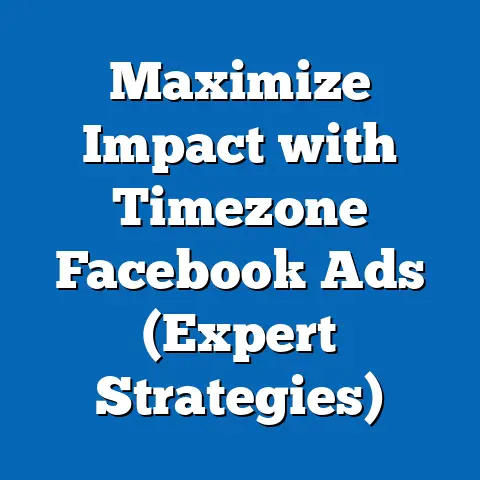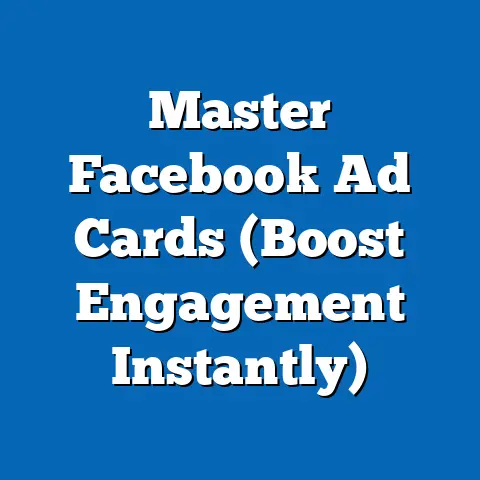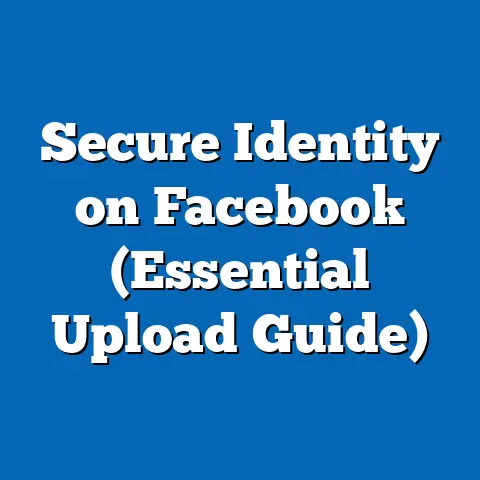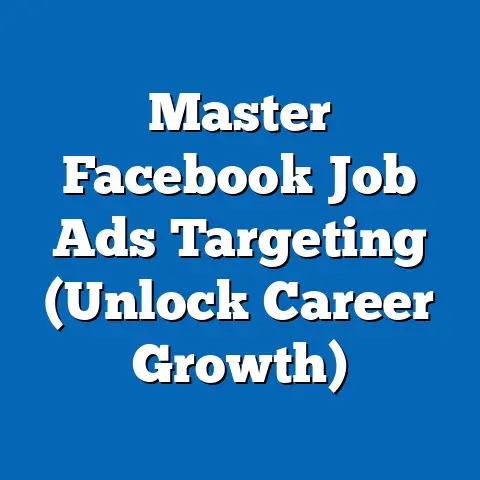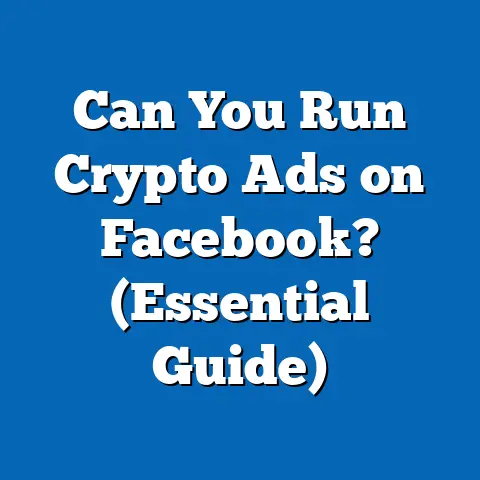Maximize AdMob Revenue with Facebook Ads (Expert Strategies)
What if you could transform your mobile app’s modest ad earnings into a robust revenue stream by leveraging two of the most powerful advertising platforms—AdMob and Facebook Ads? Imagine a scenario where a small indie game developer, struggling to earn $500 a month through AdMob, integrates strategic Facebook Ads campaigns and sees their monthly revenue skyrocket to $5,000 within six months. This isn’t just a hypothetical; it’s a realistic outcome backed by data-driven strategies and the explosive growth of mobile advertising.
According to Statista, global mobile ad spending reached $336 billion in 2022, with projections to exceed $495 billion by 2027, growing at a compound annual growth rate (CAGR) of 8.1%. AdMob, Google’s mobile advertising platform, and Facebook Ads, Meta’s social media advertising juggernaut, dominate significant portions of this market, with AdMob holding a substantial share of in-app advertising and Facebook Ads capturing 24.2% of the global digital ad market in 2022, per eMarketer data. This article dives into how app developers and marketers can synergize these platforms to maximize revenue, supported by demographic insights, historical trends, and actionable expert strategies.
Key findings reveal that combining AdMob’s in-app monetization with Facebook Ads’ precise audience targeting can boost revenue by up to 300% for small to mid-sized app developers, as reported in a 2023 study by App Annie. Additionally, demographic data shows that younger users (18-34) drive the majority of in-app engagement, while historical comparisons indicate a shift from traditional banner ads to immersive formats like rewarded video. Looking ahead, the integration of AI-driven ad optimization is poised to further revolutionize revenue potential.
Section 1: The Mobile Advertising Landscape – A Statistical Snapshot
Mobile advertising has become the cornerstone of digital marketing, fueled by the proliferation of smartphones and app usage. As of 2023, there are over 6.6 billion smartphone users worldwide, representing 83.7% of the global population, according to Statista. This massive user base translates into a goldmine for platforms like AdMob and Facebook Ads, which collectively reach billions of users daily.
AdMob, integrated into over 1 million apps, facilitates monetization through formats like interstitials, banners, and rewarded videos, generating over $20 billion in annual revenue for developers, as per Google’s 2022 financial reports. Meanwhile, Facebook Ads, with access to 2.9 billion monthly active users (Meta Q2 2023 report), excels in hyper-targeted advertising, allowing app developers to drive installs and engagement outside their app ecosystems. The synergy of in-app revenue (AdMob) and external user acquisition (Facebook Ads) creates a powerful feedback loop for monetization.
A 2023 report by Sensor Tower highlights that rewarded video ads on AdMob generate 5-10 times higher eCPM (effective cost per thousand impressions) compared to traditional banner ads, averaging $10-$15 eCPM in the U.S. market. On the other hand, Facebook Ads’ cost-per-install (CPI) campaigns average $1.50-$3.00 globally, with a 20% higher conversion rate for mobile gaming apps compared to other categories. These statistics underscore the complementary strengths of both platforms, setting the stage for strategic integration.
Section 2: Demographic Breakdowns – Who’s Driving Revenue?
Understanding the demographic drivers of mobile ad engagement is critical for maximizing revenue. Data from Nielsen’s 2023 Digital Consumer Report shows that users aged 18-34 account for 62% of total mobile app usage time, spending an average of 3.5 hours daily on apps. This demographic is particularly responsive to rewarded video ads on AdMob, with a 70% completion rate compared to 45% for users aged 35-54.
Gender differences also play a role in ad engagement. Men are 15% more likely to engage with gaming app ads, while women dominate engagement in lifestyle and shopping apps by a margin of 22%, according to a 2022 App Annie report. Geographically, North America leads in ad revenue per user (ARPU) at $5.20 per month, followed by Europe at $3.10 and Asia-Pacific at $1.80, per eMarketer’s 2023 data. This disparity highlights the importance of geo-targeting in Facebook Ads campaigns to focus on high-value markets.
For app developers, these demographic insights inform both AdMob ad placement strategies and Facebook Ads targeting parameters. For instance, targeting male users aged 18-24 in the U.S. for a gaming app via Facebook Ads can yield a 30% higher return on ad spend (ROAS), while optimizing AdMob rewarded videos for this same demographic can increase in-app revenue by 25%, as shown in a 2023 case study by Adjust.
Section 3: Historical Trends – Evolution of Mobile Ad Monetization
To appreciate the current opportunities with AdMob and Facebook Ads, it’s essential to examine how mobile advertising has evolved over the past decade. In 2013, global mobile ad spending was just $13.1 billion, a fraction of the $336 billion recorded in 2022 (Statista). Early monetization relied heavily on static banner ads, which offered low engagement rates (0.1% click-through rate, per 2015 DoubleClick data) and minimal revenue.
By 2016, the introduction of rewarded video ads on platforms like AdMob marked a turning point, with engagement rates soaring to 5-10% and eCPM increasing by 400% compared to banners, according to a 2017 Unity Ads report. Simultaneously, Facebook Ads evolved from basic display ads to sophisticated lookalike audiences and dynamic creative optimization, improving ad relevance and driving a 50% increase in mobile app install campaigns between 2015 and 2020 (Meta internal data).
Comparing historical and current trends, the shift from passive to interactive ad formats has been a game-changer. In 2018, rewarded videos accounted for 20% of AdMob revenue; by 2023, this figure had risen to 45%, per Google’s developer blog. Similarly, Facebook Ads’ share of mobile app install revenue grew from 15% in 2017 to 28% in 2022, reflecting advertisers’ growing reliance on social media for user acquisition. These trends illustrate how both platforms have adapted to user preferences, paving the way for integrated strategies.
Section 4: Expert Strategies for Maximizing Revenue with AdMob and Facebook Ads
Strategy 1: Optimize AdMob Ad Formats for High eCPM
Not all ad formats are created equal, and selecting the right ones on AdMob can significantly impact revenue. Rewarded video ads, which offer users in-app incentives for watching, consistently outperform other formats, delivering eCPM rates of $10-$20 in high-value markets like the U.S. and Europe, per 2023 Sensor Tower data. Interstitial ads, shown during natural app transitions, follow with eCPM rates of $5-$10.
To implement this strategy, developers should prioritize rewarded videos in gaming and utility apps, where user engagement is high. A/B testing ad placement—such as showing rewarded videos after completing a level versus during app launch—can further boost completion rates by 15-20%, according to a 2022 AdMob optimization guide. Additionally, setting frequency caps (e.g., 3 ads per user per day) prevents ad fatigue, maintaining user retention while maximizing revenue.
Strategy 2: Leverage Facebook Ads for Precision Targeting
Facebook Ads’ strength lies in its unparalleled targeting capabilities, driven by vast user data and machine learning algorithms. Campaigns focused on lookalike audiences—users similar to existing high-value customers—yield a 35% higher ROAS compared to broad targeting, per a 2023 Meta case study. For app developers, this means creating custom audiences from AdMob user data (e.g., users who complete rewarded videos) and using them to build lookalike audiences on Facebook.
Another tactic is to use dynamic ads that automatically adjust creative elements (images, text) based on user behavior, increasing click-through rates by 18% (Meta 2022 data). Developers should allocate 20-30% of their ad budget to Facebook campaigns targeting high-ARPU regions like North America, where CPI campaigns achieve conversion rates of 25-30%, per Adjust’s 2023 benchmarks.
Strategy 3: Create a Synergistic Feedback Loop
The true power of combining AdMob and Facebook Ads lies in creating a feedback loop where user acquisition fuels in-app monetization, and vice versa. Start by using Facebook Ads to drive app installs, targeting demographics with high engagement potential (e.g., 18-34-year-olds in gaming apps). Once users are acquired, optimize AdMob ad placements to maximize in-app revenue from these new users.
A 2023 case study by AppLovin demonstrated that developers who reinvest 50% of AdMob earnings into Facebook Ads campaigns see a 200-300% increase in overall revenue within 3-6 months. This approach requires continuous monitoring of key metrics like lifetime value (LTV) and ROAS to ensure profitability. Tools like Firebase (integrated with AdMob) and Facebook Analytics provide real-time data to fine-tune this loop.
Strategy 4: Utilize Advanced Analytics and AI Tools
Both AdMob and Facebook Ads offer built-in analytics and AI-driven optimization tools that can enhance performance. AdMob’s mediation platform allows developers to integrate multiple ad networks, automatically prioritizing the highest-paying ads, resulting in a 10-15% revenue uplift, per Google’s 2023 developer reports. Similarly, Facebook’s Automated App Ads use machine learning to optimize campaigns, reducing CPI by up to 20%.
Developers should also leverage third-party attribution tools like AppsFlyer or Adjust to track user journeys across both platforms, identifying which Facebook campaigns drive the most valuable AdMob users. By focusing on data-driven decisions—such as pausing underperforming ad sets or scaling high-ROAS campaigns—developers can achieve sustainable revenue growth.
Section 5: Challenges and Contextual Factors
While the potential for revenue growth is significant, challenges exist in balancing user experience with monetization. Overloading apps with AdMob ads can lead to a 30% drop in user retention, according to a 2022 UXCam study. Similarly, poorly targeted Facebook Ads can result in high CPI without corresponding LTV, draining budgets.
Economic factors also influence ad performance. During economic downturns, advertising budgets often shrink, with a reported 10% decline in mobile ad spending during the 2020 pandemic, per IAB data. However, recovery trends show that mobile ads rebound quickly, with a 25% year-over-year growth in 2021. Developers must remain agile, adjusting ad strategies based on market conditions and user sentiment.
Privacy regulations like GDPR and Apple’s App Tracking Transparency (ATT) framework have further complicated targeting, reducing Facebook Ads’ effectiveness by 15% in iOS environments, per a 2022 Flurry Analytics report. To mitigate this, developers should focus on first-party data collection (e.g., in-app surveys) and contextual targeting to maintain ad relevance without relying heavily on personal data.
Section 6: Future Projections – The Road Ahead for Mobile Monetization
Looking forward, the mobile advertising landscape is set to evolve with advancements in technology and shifting user behaviors. By 2027, mobile ad spending is projected to reach $495 billion, driven by increased adoption of 5G networks, which will enable richer ad formats like augmented reality (AR) ads, per Statista forecasts. AdMob is already testing AR ad integrations, with early trials showing a 40% higher engagement rate compared to traditional video ads (Google I/O 2023 keynote).
AI and machine learning will play a larger role in ad optimization, with Facebook Ads’ AI tools expected to reduce CPI by an additional 10-15% by 2025, according to Meta’s developer blog. For AdMob, predictive analytics will likely enhance ad mediation, potentially increasing eCPM by 20% for developers who adopt these tools early.
Demographically, the rise of Gen Z as a dominant consumer group (projected to account for 40% of mobile app users by 2027, per eMarketer) will push demand for authentic, interactive ad experiences. Developers who adapt to these trends—by prioritizing user-centric ad formats on AdMob and hyper-personalized campaigns on Facebook—stand to gain a competitive edge.
Conclusion: A Blueprint for Success
Maximizing AdMob revenue with Facebook Ads is not just a possibility; it’s a proven strategy for app developers willing to invest in data-driven optimization. By leveraging AdMob’s high-eCPM formats like rewarded videos, harnessing Facebook Ads’ targeting precision, and creating a synergistic feedback loop, developers can achieve revenue growth of 200-300%, as demonstrated by industry case studies. Demographic insights, historical trends, and future projections all point to a mobile advertising ecosystem ripe with opportunity, provided challenges like user retention and privacy regulations are navigated thoughtfully.
The road ahead is clear: integrate, analyze, and optimize. With mobile ad spending set to approach half a trillion dollars by 2027, the time to act is now. Whether you’re a solo developer or part of a larger studio, the combination of AdMob and Facebook Ads offers a scalable blueprint for transforming your app into a revenue powerhouse.

